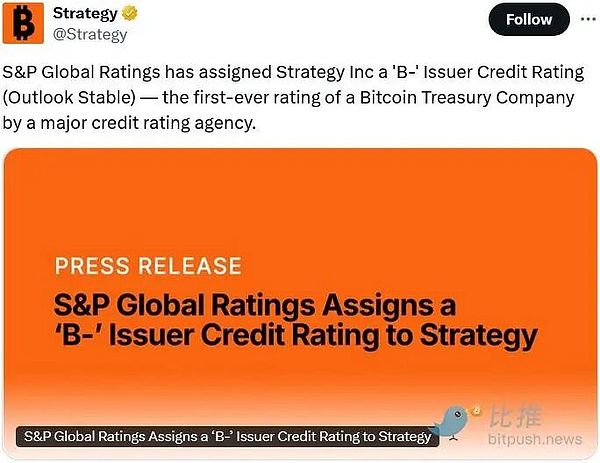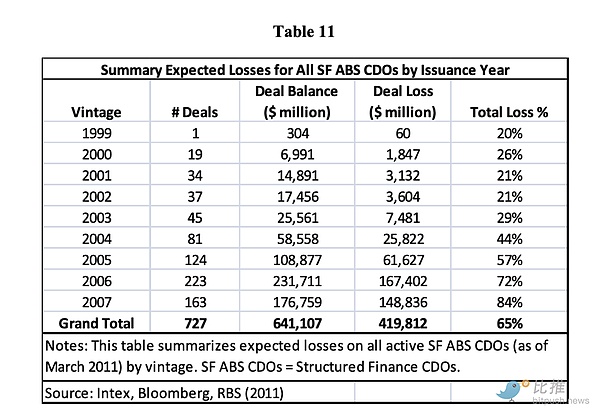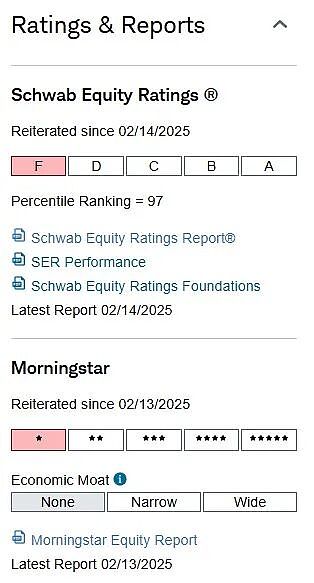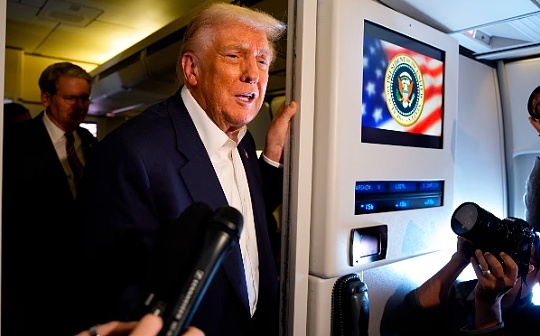
S&P GlobalRatings (S&P Global Ratings) willStrategyInc. (formerly MicroStrategy)latestThe long-term credit rating is set at B- with a “stable” outlook.

On the face of it, this is a “non-investment grade” rating.But if you put it in the context of the development of the encryption industry, this result just reveals a deeper problem: traditional rating models still have significant understanding and valuation bias when facing emerging paradigms such as “Bitcoin Treasury Companies”.
Strategy’s business model is very clear: it continues to purchase Bitcoins through the issuance of stocks, convertible bonds, preferred stocks and bonds and other methods of financing, and has accumulated a total of approximately 640,000 Bitcoins so far.
This means that the company’s core logic is not to rely on the software business to make profits, but to build a new corporate structure with Bitcoin assets as the core and capital market financing capabilities as the support.The set of standards traditionally used to evaluate “operating companies” are basically ineffective here.
However, S&P still used its inherent framework in the rating report, focusing on the following risks: excessive asset concentration in Bitcoin, single business structure, weak risk-adjusted capital strength, insufficient U.S. dollar liquidity, and the “currency mismatch” problem in which debts are all denominated in U.S. dollars but assets are dominated by Bitcoin.
Traditional rating system: not always “right”
Historically, credit rating agencies such as S&P have not always been accurate during major financial change cycles.
Back in the mid-2000s, U.S. structured financial products (particularly CDOs with underlying subprime mortgages) were issued with a large number of high ratings, many even being labeled AAA.The study pointed out that between about 2005 and 2007, the United States issued 727 “asset-backed CDOs (SF ABS CDOs)” with a total scale of about US$641 billion, and the cumulative write-downs of these products after the crash were about US$420 billion.

Wikipedia and other information point out: “Many CDOs issued in 2005-2007, after receiving the highest ratings, were downgraded to junk status or suffered principal losses by 2010.” During these events, financial giants such as Lehman Brothers were deeply involved in CDO and MBS assets. When the value of these assets plummeted and leverage became out of control, they eventually led to bankruptcy or acquisition.
In other words: Structured products that rating agencies “understood” as A (or higher) grade ended up becoming the hardest-hit areas.This illustrates the fact that when the market changes, the old model is prone to misjudgment.
Back to Strategy, perhaps traditional rating agencies have seen that: it does not have traditional diversified income, liquidity may be suppressed by Bitcoin fluctuations, debts are denominated in US dollars, and assets are denominated in Bitcoin, which means that if Bitcoin plummets, the debt repayment chain may be damaged.But at the same time, the industry is also seeing the fact that the reason why the Strategy model is established is that the capital market, Bitcoin’s global liquidity, and institutional funds all provide underlying support for it.Traditional models do not fully incorporate this logic.
The “old system” that cannot be woken up
Not only S&P, but many well-known traditional investment research institutions are using the old framework to look at crypto asset companies.
For exampleCharles SchwabThe Schwab Equity Ratings system (A to F, with F being the lowest performance expectation) has almost always beenCoinbase(COIN) and MicroStrategy (MSTR) are rated F.

And what happened during this period?
-
COIN has doubled its market price multiple times from 2022 to 2025, but Schwab still maintains F
-
MSTR up over 1000% since 2020, Schwab remains F
-
Ratings unchanged even when MSTR’s actual results in some quarters were much better than analysts’ expectations
-
This is not one time, but years of consistent low reviews.
In other words:Prices change, the market changes, the Bitcoin narrative changes, but the model doesn’t change.
Schwab isn’t “mistaken” — it just insists, following its modeling logic, that these companies “do not fit traditional earnings logic.”
Similarly, the credit ratings of Coinbase by Moody’s and Standard & Poor’s have remained in the speculative range for a long time, and the reasons given are also:
-
High business volatility
-
Revenue depends on market cycles
-
Lack of predictable cash flow
-
Risk exposure is too concentrated
Sound familiar?This is the same template as the logic given to Strategy B-.
Summary
In fact, it’s not complicated: the root of the problem is that they are still using the previous generation’s valuation model to measure the next generation’s asset form.
Traditional financial institutions are not unprofessional, they just stick to their own mature thinking language.In their cognitive system, a high-quality asset must be able to generate predictable cash flow, a healthy business must be able to operate stably in a low-volatility environment, and its valuation must strictly follow comparable company analysis or income approach models.
However, emerging crypto treasury companies tell a completely different story.Their core logic is: “We do not rely on traditional operating cash flow to support asset values, but gain strong financing and market confidence through innovative asset structures.” This is not a simple debate between right and wrong, but a profound paradigm change.
Therefore, the B- rating S&P gave Strategy this time is not in itself critical.The truly symbolic signal is that the new model represented by the Bitcoin Treasury has developed to the point where the traditional rating system can no longer ignore it and has to try to “explain” it.
But we must be soberly aware that “explanation” does not mean “understanding”, “understanding” does not mean “acceptance”, and “acceptance” does not mean incorporating it into the mainstream framework.The cognitive transformation of the old system will be as slow as the movement of a glacier – it will wake up, but never overnight.
And history has repeatedly proved that a new market structure is often quietly finalized while the old system is “half dreaming and half awake”.
Putting Bitcoin on corporate balance sheets has gone from a pioneering experiment to a fait accompli.Whether the traditional world recognizes it, accepts it, or even truly understands it is only a matter of time.





